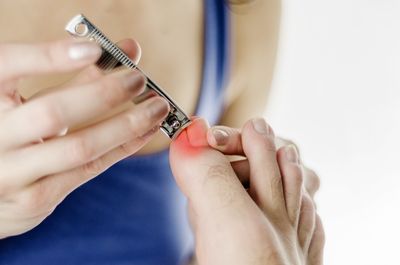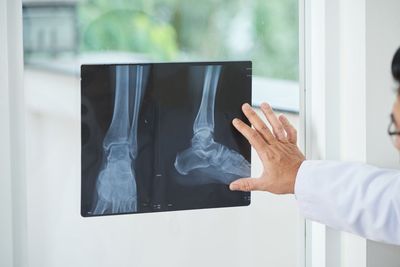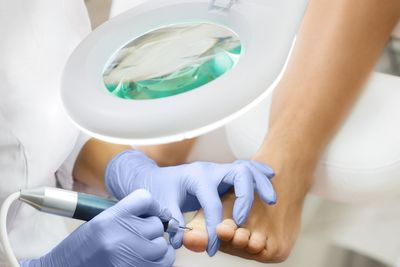CONDITIONS TREATED
Common Podiatric Conditions
There are many different types of podiatric conditions and injuries
that can affect your life, cause you intense pain and even prevent you from being able to walk. When you visit Port Washington Podiatry, our qualified and compassionate staff will take the time to fully understand your issues and help come up with a treatment plan just for you.



Achilles Tendon Disorders
The Achilles tendon is the longest tendon in the body. It runs down the back of the lower leg and connects the calf muscle to the heel bone. Also called the “heel cord,” the Achilles tendon facilitates walking by helping to raise the heel off the ground.
Ankle Sprain
Ankle sprains are injuries to the ligaments typically on the outside of the ankle joint. Sprains are usually brought on by twisting of the ankle.
Bunions
There are several attributing factors that can lead to a symptomatic bunion deformity. Heredity plays in important role in the development of this deformity as well as abnormal mechanical function of the foot. Statistically, more women have symptomatic bunion deformities than men do.
Crossover Toe
Crossover toe occurs when the second toe moves closer and eventually crosses over and lies on top of the big toe.
Diabetic Complications & Amputation Prevention
Diabetics are at an increased risk for foot problems. However, consistent visits with your podiatrist can decrease the chance for infection or problems to develop.
Flexible Flatfoot
Flatfoot is often a complex disorder that can occur in several planes (transverse, sagittal, frontal). It is characterized by a low arch, which puts increased stress on the ligaments and tendons on the inside of the foot and ankle.
Fractures Of The Digits And Metatarsals
A fracture is defined as a break in the bone. Fractures can be divided into two categories: traumatic fractures and stress fractures.
Ganglion Cyst
A ganglion is a gelatinous, fluid-filled out-pouching of the lining of a joint or tendon. Typically, ganglion cysts grow slowly and occur on the foot or ankle.
Gout
Gout, or a gouty attack, is caused by an increase in the amount of uric acid crystals in the body.
Haglund’s Deformity
Haglund’s deformity is a bony enlargement on the back of the heel. Usually, the enlarged bone causes increased pressure on the soft tissue of the posterior heel leading to bursitis, or an inflammation of a fluid-filled sac between the tendon and bone.
Hallux Rigidus
Hallux rigidus is an arthritic condition often leading to pain and stiffness within the big toe joint. This condition is recognized when there is decreased motion in the joint, causing a gradual wearing away of the smooth surface (cartilage) of the joint.
Hammertoes
If a hammertoe deformity progresses, it can lead to irritation in shoe gear and to the development of a corn or bursa. A large development of keratinized skin of the outer layer (stratum corneum) builds up to prevent further irritation of the epidermis.
Heel Pain (Plantar Fasciitis)
Heel pain can encompass several different problems depending on the exact location and quality of the pain (i.e. tendonitis, stress fracture). However, plantar fasciitis is the most common diagnosis associated with heel pain.
Ingrown Toenails
The nail plate is made up of the same type of cells that make up our skin, which is the largest organ of the human body. The most common problem with human toenails are when they become embedded in the surrounding skin, or nail fold. This is known as an ingrown toenail.
Morton’s Neuroma
Morton’s neuroma is a painful fibrotic enlargement of one of the common digital nerves. The majority of neuromas are benign, but can also be cancerous. The term “neuroma” actually means a “tumor of a nerve.” Initially described by a British physician, the problem most often occurs between the bases of the third and fourth toes.
Peroneal Tendon Injuries
Peroneal tendon injuries vary from minimally debilitating to severe pain.
Puncture Wounds
Puncture wounds occur when a foreign object, such as a nail, glass or piece of wood, enter the skin a cause a hole. These types of wounds require immediate treatment because they often cut deep into the skin.
Tailor’s Bunion
A Tailor’s bunion, or bunionette, is an enlargement of the bone on the outside of the foot (fifth metatarsal). The bony prominence can cause increased pressure in shoes, which results in pain, redness and swelling.
Warts
A wart is a small growth on the skin that develops when the skin is infected by a virus. Plantar warts are caused by direct contact with the human papilloma virus (HPV).
BROWSE OUR WEBSITE
CONTACT INFORMATION
Address:
1317 W. Grand Ave. Port Washington, WI 53074
Phone: 262-284-8800
Email: jdjbong1@sbcglobal.net
OUR LOCATION
- Mon, Wed
- -
- Tue, Thu
- Appointment Only
- Friday
- -
- Sat - Sun
- Closed
Content, including images, displayed on this website is protected by copyright laws. Downloading, republication, retransmission or reproduction of content on this website is strictly prohibited. Terms of Use
| Privacy Policy
